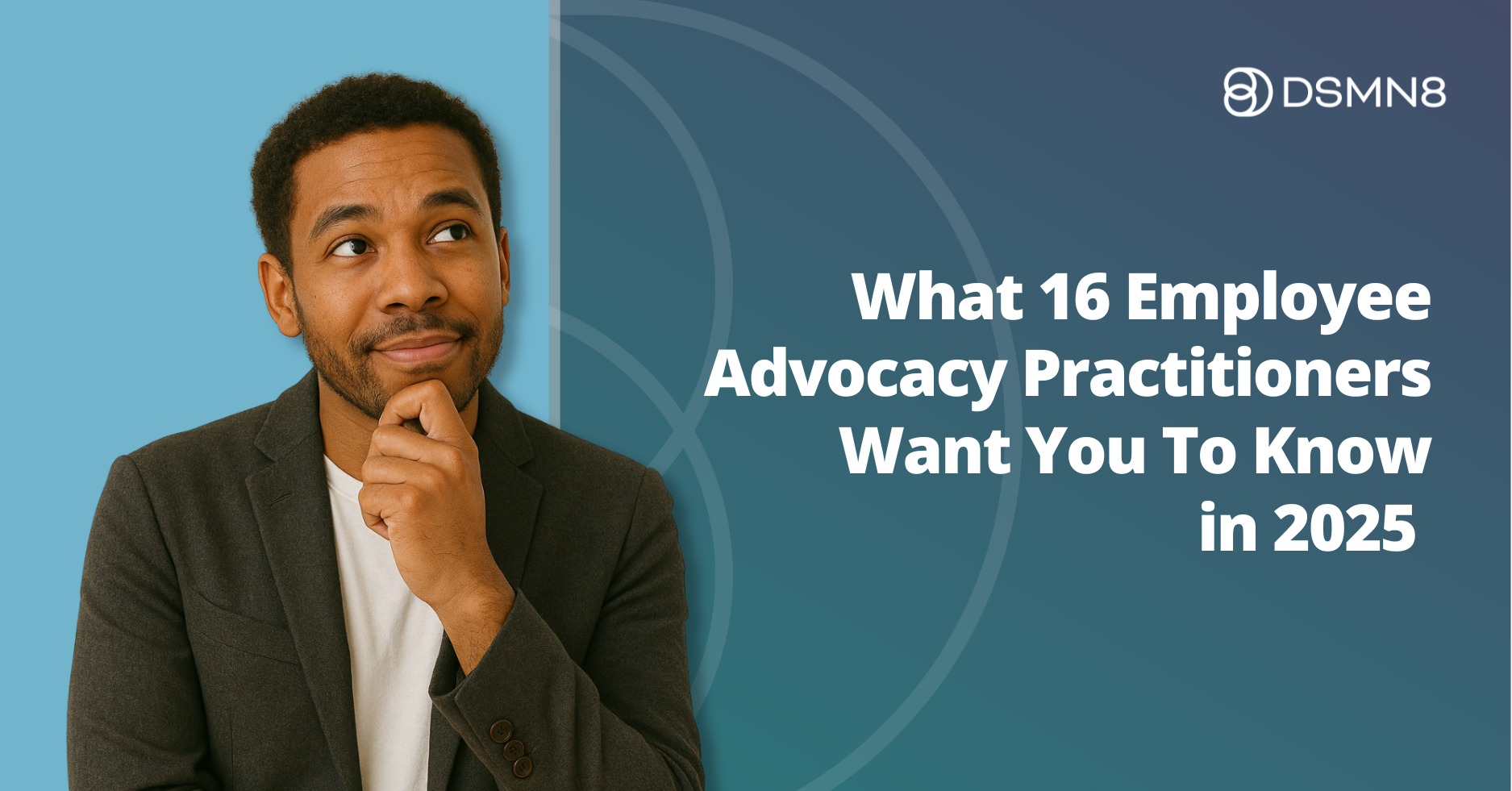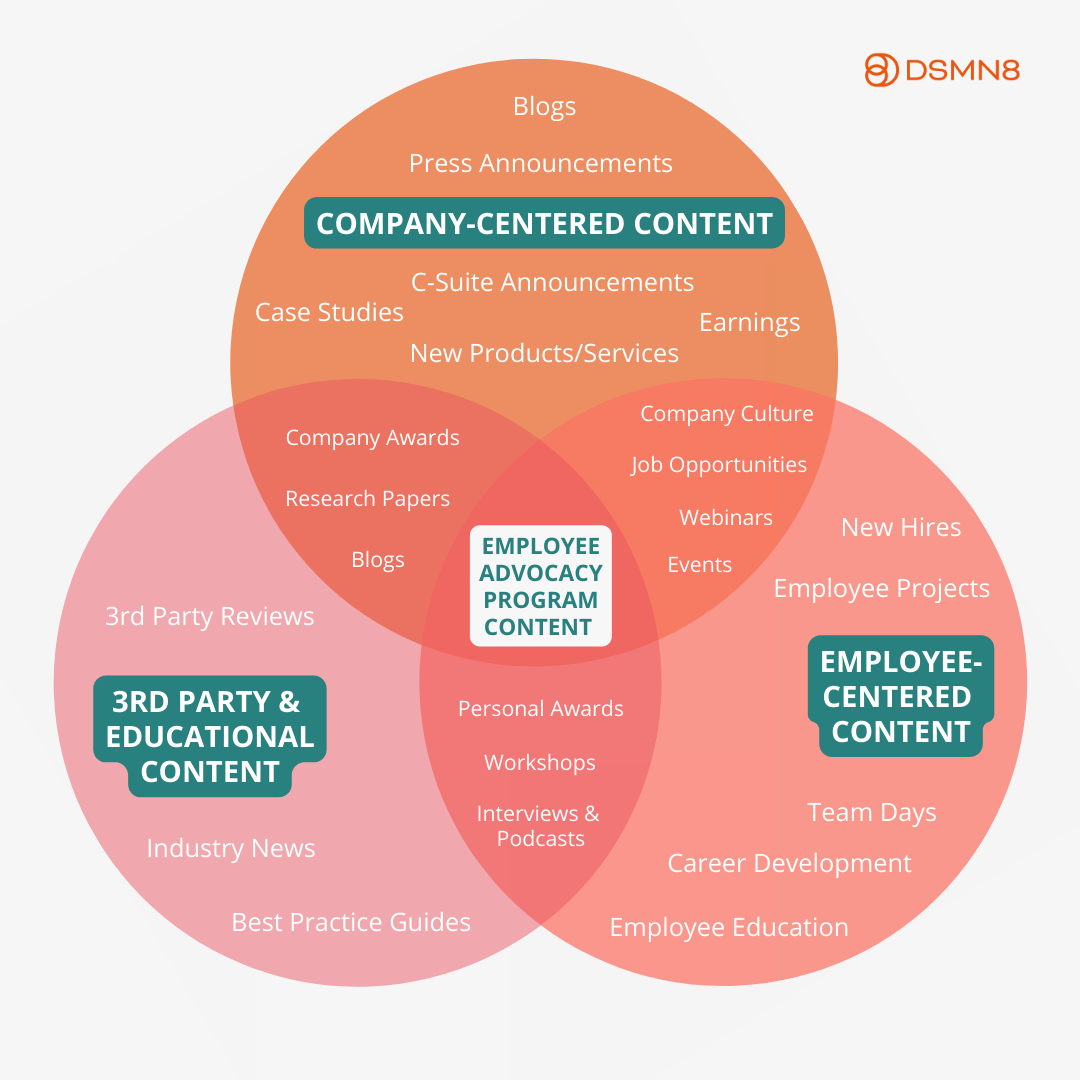
What does it really take to build a successful employee advocacy program in 2025?
As part of our Employee Advocacy Benchmark Report, we gathered insights from 250 practitioners leading advocacy programs across industries. From those conversations, today we’re spotlighting 16 standout voices who offered practical, honest advice you can act on today.
These aren’t just employee advocacy quotes, they’re hard-won insights from the people doing the work 💪
If you’re building or scaling an employee advocacy program, consider this your roadmap.
On Getting Buy-In
If you want your employee advocacy program to succeed, you need leadership support and employee alignment. Here’s how practitioners are making the case internally:
Getting our team involved in sharing content on LinkedIn has really expanded our reach.
And it’s not just about getting our brand out there, it’s also helped our employees learn more and have more buy-in with we’re talking about and sharing on the marketing side.
It’s a bit of a snowball effect in that regard.
The more people see, the more they want to be involved and be more proactive in what they share. There’s something super cool about a colleague actually liking what you’re sharing enough to want to put their own spin on it and share it with their audience. And it’s that authentic engagement that, in time, we’re seeing more of.

Darren Ralphs, Content Lead @ Sylvera.
Every colleague is a potential thought leader. As a company, it is our role to give them the tools, space, and knowledge to tell our stories, to activate their own voices, and to mobilize them towards a common goal.

Ophelie Janus, Global Head of Thought Leadership @ Siemens.
From my observations and experience, it has become easier and easier to convince senior management to implement the program in the organization.

Alina Markiewicz, Corporate Communications & Employer Branding Specialist @ Bonprix.
On Making It Easy for Employees
If your program isn’t simple and intuitive, your people won’t engage.
The best employee advocacy strategies remove friction and build confidence 💪
Technological advancements have facilitated the seamless integration of advocacy programs into daily workflows, making it easier for employees to share content and insights.
Moreover, organizations are investing in comprehensive training and incentives to empower their workforce as brand ambassadors, resulting in a more connected and trusted brand presence in the market.

Valentin Eder, Social Media Specialist @ ALTEN Germany.
Employee advocacy has truly come into its own, evolving into a sophisticated and data-driven strategy.
Companies are now using advanced platforms that offer detailed analytics, helping them measure the impact of employee-shared content and fine-tune their approaches.
These tools seamlessly integrate with other marketing and sales systems, giving a comprehensive view of campaign effectiveness.

Vahbiz Cooper, Digital Marketing Manager @ Demandbase.
On Why Culture Matters
A positive company culture is the foundation of advocacy success. It creates the trust, transparency, and sense of belonging that empowers employees to share authentically.
Employee advocacy transcends mere amplification of voices; it is fundamentally about embedding those voices into the heart of the company culture.
When employees are genuinely aligned with and engaged in the company’s values, they naturally become its most authentic ambassadors, fostering a culture where advocacy and organizational success are intertwined.

Odai Marie, Head of MarCom Media at NEOM.
Modern audiences are becoming desensitized to repetitive, company-centric posts, craving authenticity and individuality instead. Effective employee advocacy programs embrace this shift by allowing for personalized messaging that reflects the unique voice of each employee, thereby standing out in a crowded digital space.
Moreover, the best advocacy initiatives offer training, empowering employees to emerge as thought leaders within their fields. This not only enriches their professional growth but also enhances the company’s brand by positioning its employees as the focal point of its storytelling. In today’s market, authenticity leads to engagement, and by fostering genuine connections, advocacy programs can transform employees into the company’s most valuable ambassadors.

Drew Hawkins, Senior Director, Marketing & Operations @ Womble Bond Dickinson.
Employee advocacy is a journey of small, steady steps.
It begins with basics like social media do’s and don’ts policies.
Slowly, it activates different triggers within the organization: there is a need for a more aligned messaging, or graphic design trainings for employees.
This journey not only not only enhances external brand awareness but also boosts internal collaboration and strengthens us as a team.

Saori Sakaguchi-Spee, Global Social Media Marketing & Communications Manager @ Barentz.
Focusing on employee experience has become essential. Companies know that happy, engaged employees make the best advocates.
Investing in a positive work culture, offering training, and recognizing and rewarding advocacy efforts are key.
Programs like Demandbase’s Brand Ambassador for the Month highlight how organizations can celebrate and incentivize employee participation.

Vahbiz Cooper, Digital Marketing Manager @ Demandbase.
🎧 Check out our podcast episode featuring Vahbiz to learn more about Demandbase’s approach:
On Content That Works
No one wants to share content that feels forced, boring, or off-brand. The best employee advocacy content is relatable, resonant, and ready to go.
This includes creating ready-to-use content, such as social media posts, articles, and videos, that employees can easily share. Leveraging technology, such as employee advocacy platforms and social media management tools, streamlines the process and makes it more efficient.
By enabling employees effectively, organizations can unleash the power of employee advocacy and drive positive outcomes for their brand.
Despite the myths and challenges in their implementation, it’s not necessary to be an influencer or have thousands of followers.
The key is to create storytelling that resonates with the target audience, promoting key messages and boosting the brand’s credibility.

Fabiana Renzullo, Senior B2B Social Media Marketing Specialist @ Jalasoft.
1. Use your employees as an amplification army by giving them access to a content platform to generate mentions and engagements;
2. Enable employees to build and maintain personal relationships with target audiences by giving them the right skills, tailored content, and performance measurement.
You don’t have to choose one or the other; successful programmes support both, with type 1 for the masses and type 2 for those with the most impact potential.

Joe Morris, Global Social Media and Employee Advocacy Leader.
On Employee Motivation
Advocacy doesn’t happen without participation, and participation doesn’t happen without motivation.
From personal growth to internal recognition, here’s what drives involvement:
A brand advocacy program should not be about employees consistently sharing positive experiences. First, it should focus on helping them open up and encouraging them to make baby steps to bigger authority in their niche.

Olga Andrienko, VP of Marketing Operations @ Semrush.
This trend not only strengthens the company’s reputation but also fosters a sense of belonging and pride among employees, resulting in higher retention and attraction of talent.
At Thomson Reuters, we are committed to training our employees and ensuring they are ready to share their authentic experience of working here. Through their advocacy, we aim to spark interest in our company and attract top talent to join us.

Raul Velazquez Arteaga, Global Employer Brand Lead @ Thomson Reuters.
But let’s not forget the huge benefit for each individual employee. Each member of the team can begin positioning themselves as a thought leader and building their own networks.
The time investment does not have to be onerous but the results can be a real game-changer for individuals and companies as a whole.

Sarah Clay, LinkedIn Trainer & Author.
Surveying users for program and content effectiveness can help toward this goal as well as promoting the program to new employees.

Tanya Figueroa, Senior Specialist, Digital Brand Marketing & Engagement, Epson.
Employees are no longer just seen as brand ambassadors or notice boards but as genuine advocates who are empowered to share their unique perspectives and experiences.
We are here not to deliver content and encourage them to post. Our role is to educate them, equip them with personal branding knowledge, and let them shine for us.

Agata Qanadilo, Employer Brand and Recruitment Marketing Manager @ AstraZeneca.
Final Thoughts & Additional Resources
From getting buy-in to keeping momentum, these voices prove one thing: successful employee advocacy isn’t luck—it’s built.
Built on trust. On simplicity. On culture. On content that resonates. And on real motivation, not mandates.
Take these insights, apply them to your program, and start turning employee advocacy into your company’s unfair advantage.
Ready to get started?
Book a Demo with DSMN8, the #1 User-Rated Employee Advocacy Platform.
P.S. Grab the full Benchmark Report for more expert insights and statistics 👇
Emily Neal
SEO and Content Specialist at DSMN8. Emily has 10 years experience blogging, and is a pro at Pinterest Marketing, reaching 1 million monthly views. She’s all about empowering employees to grow their personal brands and become influencers.






